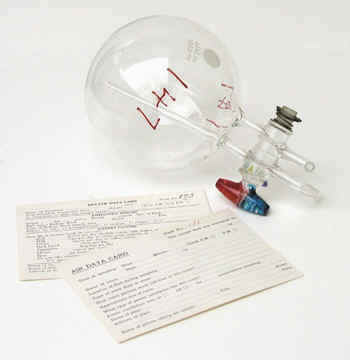Ionization Chamber of Robley Evans

This ion chamber was constructed for Robley Evans at MIT (ca. 1940) for the analysis of breath samples from workers in the radium industry. Entirely constructed from brass, it is approximately 11" tall and 5.5" in diameter. The tip of the electrical connection to the anode is visible in the opening of the short tube on the top of the chamber. The valve used to evacuate the chamber and to connect to the sample flask is seen pointing towards the left. For convenience, the chamber comes with two carrying handles.
It was desirable that the sample be collected in an uncontaminated room some distance away from the radium department, preferably with all the windows open. In addition, the individual providing the sample should not have participated in radioactive work for the previous three or more hours. The subject was required to exhale approximately one breath of every four for a period of ten minutes or so into a one-liter spherical glass flask. Information about the collection procedure and the individual from whom the sample was collected was recorded on data cards. This information included, among other things, the individual’s name, information pertaining to their work, calcium-rich foods and beverages in their diet, and the time, date and supervision of the sample collection.
After the sample had been transferred to the ion chamber, the radon concentration was determined via the current generated by the alpha emissions of the radon and its polonium decay products. A very similar stainless steel ion chamber was produced in the 1950s by the Atomic Instrument Company of Cambridge Massachusetts, the Model 972 Radon Chamber. The latter was 14" high and 8" in diameter, it weighed 15 pounds at operated at 150 volts.

The photograph to the right shows one of the one-liter glass flasks used by Robley Evans to collect breath samples. Evans preferred glass because rubber and other organic materials had a tendency to absorb some of the radon.
The photograph also shows two of the data cards used to record information about the individual from whom the sample was collected.
Items donated by David Allard.
References
- Evans, Robley, Radium Poisoning II The Quantitative Determination of the Radium Content and Radium Elimination Rate of Living Persons, Am. J. Roentgenol. And Radium Therapy, 37: 368-378, 1937.
- Evans, Robley, Protection of Radium Dial Workers and Radiologists from Injury by Radium, J. Ind. Hygiene and Tox. 25 (7): 253-269, 1943.
- Evans, Robley, Apparatus for the determination of minute quantities of radium, radon and thoron in solids liquids and gases. Rev. Sci. Instr. 6: 99-112, 1935.
- Evans, Robley, Ionization currents produced by Radon, RaA and RaC in cylindrical ionization chambers. Physical Review 48: 177-186, 1935.
- S. Atomic Energy Commission. RIB-8. Radiation Instrument Catalog No. 3. July 1, 1952. page BIC 15A.
